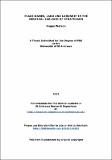Files in this item
Place-names, land and lordship in the medieval earldom of Strathearn
Item metadata
| dc.contributor.advisor | Crawford, Barbara | |
| dc.contributor.advisor | Taylor, Simon | |
| dc.contributor.author | Watson, Angus | |
| dc.coverage.spatial | 646 p. | en_US |
| dc.date.accessioned | 2017-07-31T10:56:53Z | |
| dc.date.available | 2017-07-31T10:56:53Z | |
| dc.date.issued | 2002-06 | |
| dc.identifier.uri | https://hdl.handle.net/10023/11331 | |
| dc.description.abstract | The first aim of this thesis is to present a comprehensive toponymic listing and analysis for six parishes of Western Strathearn, and this is done in Part One where approximately 2500 place-names are considered. The medieval parishes of BQR, COM, TEX, MUT, MZX and MXZ form a continuous, largely upland, area, topographically distinct from the Strathearn parishes to the east, and with the exception of Innerpeffray (part of MXZ, see esp. Part Two, Appendix 1b) somewhat less affected, in the 12c to 14c at least, by inward migration of Anglo-Norman and other non-Gaelic groups or individuals. Thus we might expect this western area to be the most conservative part of an earldom that Cynthia Neville has characterised as conservative and insular as late as 13c when compared to other major Scottish earldoms and lordships (Neville 1983, eg vol i, 156, Neville 2000, 76). The core lands of the more easterly medieval parish of FOW were subjected to the same comprehensive toponymic analysis. Though that toponymic material could not be included for reasons of space, it has contributed, along with the material from the six parishes covered in the gazetteers below, to the second main aspect of the thesis, the discussion of lordship and land organisation in Part Two. In Part Two will also be found an introduction to the earldom of Strathearn and a discussion of a number of aspects of its history, as well as appendices giving additional information relevant to the topics discussed in the body of the thesis. The parish unit was chosen as the basis for the organisation of this thesis since John Rogers (Rogers 1992, esp. 125-7) has shown the fundamental link between the form of the ecclesiastical parishes, whose creation was complete by 12c, and pre-existing units of land usually referred to as multiple estates, a multiple estate being a group of individual estates, not necessarily contiguous, organised and operated as a coherent social, tenurial and economic unit. As Rogers puts it, multiple estates were essentially units of lordship, taking the form of a principal settlement or caput with a number of dependent settlements. They contained within their bounds all the resources required to support their economies and to produce the necessary renders. Accordingly they were arranged in the landscape to exploit those resources, a process which often produced irregular geographical forms, including areas detached from the main body of the estate. This process frequently led to a specialisation of function, such as the management of pasture, amongst the component settlements. Jones (1976) discusses the multiple estate in the context of the early British Isles, Dodgshon (1981, esp. 58ff) in a Scottish context. The latter writer says (op. cit., 58) that in their variety of scale, multiple estates have often been likened to a parish, though some were undoubtedly larger, adding that lordship was exercised over them by a tribal chief, a king or a feudal baron. Many of these characteristics will be found relevant to the discussion of land organisation and lordship in Part Two. In our present state of knowledge, then, the medieval parishes are the best representation we have of the patterns of land organisation in Strathearn as they may have been in the time of the late Pictish and early Scottish kingdoms. A practical demonstration of the relevance of parish boundaries lies in the fact that it is rare indeed to find a settlement place-name whose area of reference straddles the boundary of a medieval parish. It is overwhelmingly within the context of the original parish that the place-names of an area have coherence and are most likely to give up their secrets. | en_US |
| dc.language.iso | en | en_US |
| dc.publisher | University of St Andrews | |
| dc.subject.lcc | DA880.P4W2 | |
| dc.subject.lcsh | Toponomy | en |
| dc.subject.lcsh | Names, Geographical--Scotland--Strathearn | en |
| dc.subject.lcsh | Land tenure--Scotland--Strathearn--History | en |
| dc.subject.lcsh | Feudalism--Scotland--Strathearn--History | en |
| dc.title | Place-names, land and lordship in the medieval earldom of Strathearn | en_US |
| dc.type | Thesis | en_US |
| dc.contributor.sponsor | Catherine Mackichan Bursary Trust | en_US |
| dc.type.qualificationlevel | Doctoral | en_US |
| dc.type.qualificationname | PhD Doctor of Philosophy | en_US |
| dc.publisher.institution | The University of St Andrews | en_US |
This item appears in the following Collection(s)
Items in the St Andrews Research Repository are protected by copyright, with all rights reserved, unless otherwise indicated.

